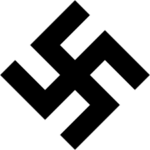
Nazi symbol
| Symbol | Nazi |
| Religion | Nazism (associated with a political ideology) |
| Origin | The swastika has origins in various cultures worldwide, symbolizing good luck, prosperity, and spirituality in Hinduism, Buddhism, and other ancient civilizations. However, its association with Nazism originates from its adoption by the Nazi Party in Germany. |
| Meaning | Originally a symbol of good fortune and well-being, the swastika was perverted by the Nazis to represent their ideology of Aryan supremacy, racial purity, and anti-Semitism. |
| Appearance | The Nazi swastika is a black, rotated cross with arms bent at right angles, typically displayed within a white circle on a red background. |
| Colors | Black (swastika), white (circle), red (background). These colors were chosen for their symbolic significance within Nazi ideology, representing Aryan purity (white), blood (red), and the struggle (black). |
| Usage | The Nazi swastika was prominently used as the official emblem of the Nazi Party, appearing on flags, uniforms, banners, and other propaganda materials during the Third Reich. |
| History | The swastika gained widespread association with Nazism during Adolf Hitler's rise to power in Germany in the 1930s. It became the central symbol of the Nazi Party and was used extensively throughout the regime's reign until its defeat in World War II. |
| Popularity | During the Nazi era, the swastika was forcefully promoted as the symbol of the regime and became widely recognized internationally due to the global impact of World War II and the Holocaust. However, its use declined sharply after the defeat of Nazi Germany. |
| Importance | The swastika holds immense historical significance as the primary symbol of one of the most infamous and destructive regimes in modern history, representing the atrocities committed under Nazi rule and the fight against fascism during World War II. |
| Complexity | The symbol's complexity lies in its dual nature: originally a benign symbol with positive connotations in various cultures, it was repurposed by the Nazis to propagate hate and oppression, resulting in a complex legacy that continues to evoke strong emotions and controversy. |
| Emotions | The swastika evokes a wide range of emotions, including disgust, anger, sorrow, and fear, due to its association with the horrors of the Holocaust, genocide, and fascist ideology. Its display is often considered highly offensive and is prohibited in many countries due to its inflammatory nature and historical context. |
The Nazi symbol, commonly known as the swastika, is a powerful emblem associated with the ideology and atrocities of the Nazi regime in Germany during the 20th century. Originally an ancient religious symbol with positive connotations in various cultures, the swastika was appropriated by the Nazi Party under Adolf Hitler’s leadership and transformed into a symbol of hate, racism, and genocide. It was prominently used on the Nazi flag, military insignia, and propaganda materials during their rule from 1933 to 1945. Today, the swastika remains widely recognized as a symbol of Nazi tyranny and is banned in several countries due to its association with hatred and crimes against humanity.